 Keyboard.
Keyboard.


Above: Don't ignore minor pains and muscle aches. It could be your body telling you that your posture
is incorrect.
Introduction.
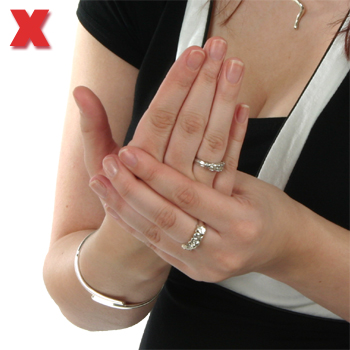
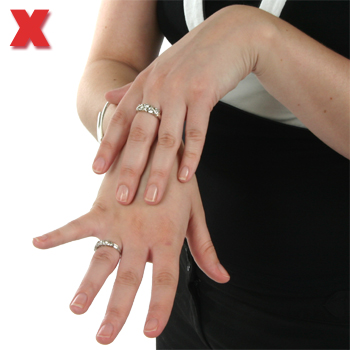
Above: Prolonged incorrect use of a keyboard and mouse can lead to an upper limb disorder.
Repetitive Strain Injury (RSI) and Upper Limb Disorder (ULD) are now the most common cause of injury at work affecting over half a million people in the UK, with 4.2million work days lost a year.
The standard QWERTY keyboard was designed for trained touch-typists aware of the importance of correct posture and hand/arm movement. Today, a high percentage of users are self-taught or non touch-typists, who aren't aware of the dangers and may have developed bad habits.
Top tips.
- Sit properly: check the upper arms are not extended forwards, the forearms are horizontal and the fingers are at the same height as the middle row of keys.
- Avoid dropping the wrists down on the desk whilst typing. Avoid resting your wrists on a wrist-wrest whilst typing.
- Learn to touch-type to avoid constantly looking between keyboard and screen.
- Avoid hitting the keys heavily: practice using a soft typing style.
- Learn the keyboard shortcuts to reduce use of the mouse.
Position.
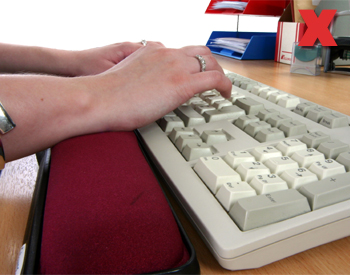
Above: Having a wrist rest is one thing, but using it correctly is another!
- Adjust the chair height so that elbows are not below the desk surface.
- Shoulders should be relaxed with the upper arms by your side and the forearms parallel with the elbows at approximately a 90 degree angle.
- wrists should be in a neutral position with the fingers positioned above the home keys, arms should not be stretched forward.
- fingers should rest above the home keys in the central row.
- keyboard should be on the desk to the front of the monitor and directly ahead of the user.
- Allow sufficient space to the front of the keyboard to rest the hands when pausing from typing.
- Avoid anchoring the wrists on a wrist rest whilst typing as this results in frequent wrist movements to the left and right.
- Ensure arm rests don't prevent the user from obtaining the correct position.
- Take care not to rake the keyboard if this results in the wrists being flexed.
- Where there is regular right hand movement between keyboard, mouse and numeric pad consider moving the mouse to the left hand, a compact keyboard and a separate number pad to avoid injury.
- Laptop users go to the Portable Equipment (link) section.
Typing techniques.


Above: Try not to press down on the keys too hard.
- The hands should float over the keys with the wrists remaining in a neutral position. Fingers should be softly curved.
- Non-touch typists using one or two fingers of each hand to access the keyboard should avoid holding the remaining fingers and thumbs rigid position as this stretches the tendons and can result in injury.
- Avoid hitting the keys heavily, as in the long term this can have an effect on the joints of the fingers.
- The wrist area is hyper-sensitive to injury: avoid having your wrists flexed back resting on the desk or wrist rest. Use the wrist rest when resting from typing.
- Consider learning to touch type. It minimises neck and head movement by allowing users to look directly at the screen. A variety of easy to use touch-typing software is available.
Select this link to view a factsheet on touch typing.
Alternative keyboards.

Above: Taking time to find the right keyboard for you is advisable.
Alternative keyboards encourage good practice and posture as well as relaxed hand movements. They may take a little time to get used to but the effort is usually worth it.
Compact keyboard.
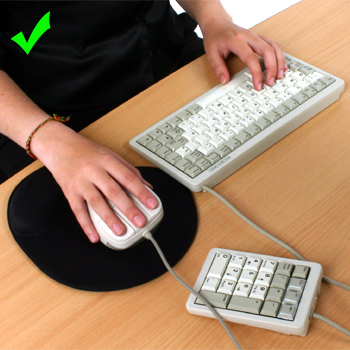
Above: Using a compact keyboard enable the user to bring the mouse into a close, more comfortable location.
- does not have a fixed numeric pad – check the frequency of use of the number pad. 80% of users don't use it at all.
- The footprint is generally much smaller than a standard keyboard, the control keys usually wrapped closer around the QWERTY section and sometimes reduced in size. The QWERTY section may look smaller than usual, but there's generally very little difference.
The Benefits for right-handed mouse users:
- Less stretching to reach the mouse, which can be placed ahead of the right shoulder.
- The QWERTY section of the keyboard can be positioned centrally, rather than over to the left hand side (as a compromise to bring the mouse nearer).
- More flexible desktop and can be easily moved to one side no matter which hand controls the mouse.
Separate numeric keypad.
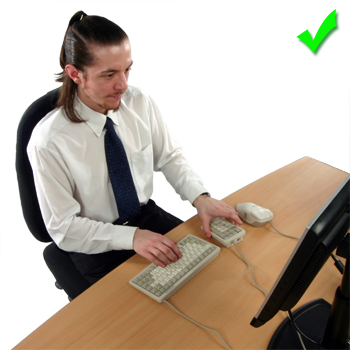
Above: Moving the numeric pad across to the left hand side of the keyboard can aid comfort.
- Can be used either side of a compact keyboard, to the left for left-handed users.
- If numeric entry dominates the workload, the pad can be placed in the most suitable position and the standard keyboard moved out of the way.
- The user can vary hand movements by swapping the mouse and numeric pad operation between hands.
- For anyone who finds operating a mouse difficult the numeric keypad can be used with MouseKeys. (skillsheet) .
Split keyboard.
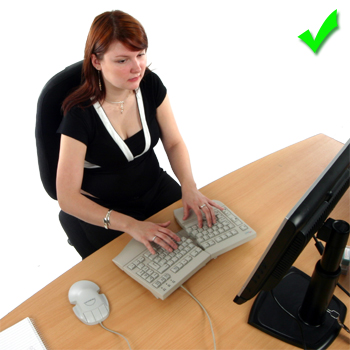
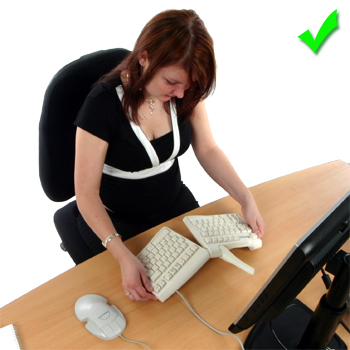
Above: Two popular ergonomic keyboards offering great flexibility for personal tuning.
- an ergonomic design suitable for touch typists only.
- encourages a more comfortable, natural hand/arm position that enables the wrists to remain in a neutral position.
Considerations for selection:
- non-adjustable style with a raised central section forming two sloping sides with the QWERTY keys split either side. The number pad is usually fixed on the right, which means there's further to stretch to the mouse if used with the right hand.
- styles with adjustable split and rake. Offer greater flexibility, and do not generally have an attached numeric pad enabling the mouse to be placed more suitably.
- the Maltron keyboard has a unique design, with the QWERTY keys divided into two sections that are bowl shaped, and the keys set at different heights to reflect finger length. Many users find it extremely useful, but it can take a little time to get used to. It is available for initial hire from the suppliers.
There are many other products and built in solutions designed for anyone who has lost their fine motor control. For further information go to www.abilitynet.org.uk.
Select this link to view a factsheet on keyboard and mouse alternatives.
Keyboard shortcuts.
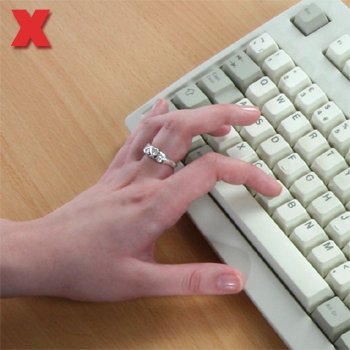
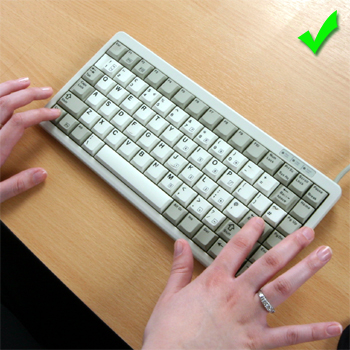
Above: When using keyboard shortcuts be careful not to stretch your hand into an
uncomfortable position.
- Shortcuts speed up the way users work and save repetitive movements with the mouse that may cause RSI.
- They need to be learnt, but by adding knowledge a little at a time and focusing on ones that will be used frequently the benefits will soon act as their own incentive. (skillsheet?)
Select this link to view a factsheet on keyboard shortcuts in Windows.
Keystroke saving techniques.
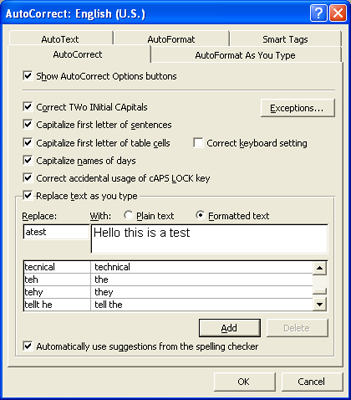
Above: AutoCorrect screenshot from Microsoft Word XP.
- Regularly used phrases, paragraphs, even sections of documentation can be assigned to shortcut keys that, when typed, will bring up the full text.
- This saves both time and repetitive hand movement, and can be achieved using AutoText and AutoCorrect in Microsoft Word . (Skillsheet)